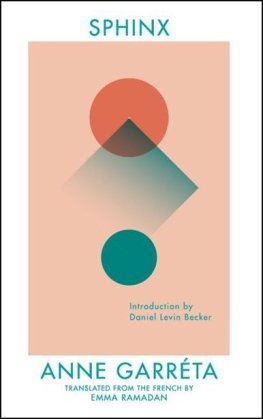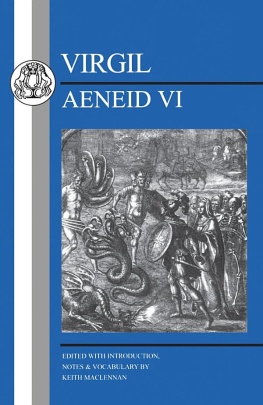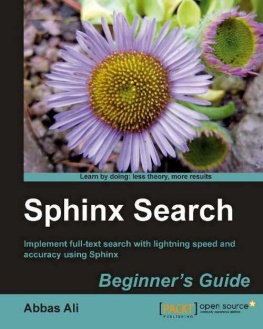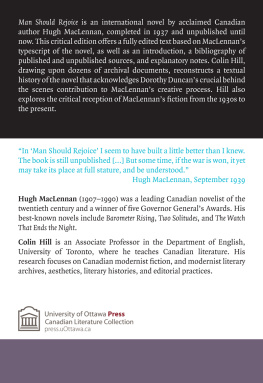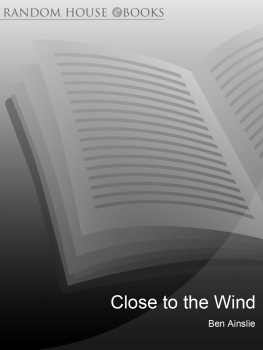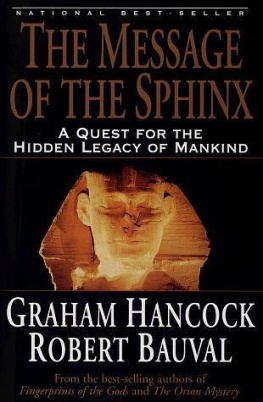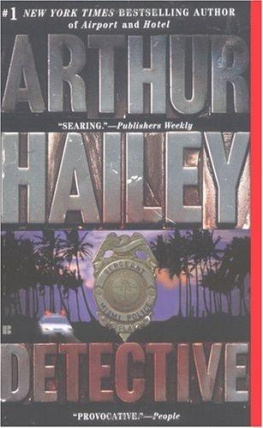RETURN OF THE SPHINX
RETURN OF THE SPHINX
HUGH MACLENNAN
Introduction: Collett Tracey
General Editor: Michael Gnarowski

McGill-Queens University Press 2009
ISBN 978-0-7735-2490-3
Legal deposit third quarter 2009
Bibliothque nationale du Qubec
Printed in Canada on acid-free paper that is 100% ancient forest free (100% post-consumer recycled), processed chlorine free
McGill-Queens University Press acknowledges the support of the Canada Council for the Arts for our publishing program. We also acknowledge the financial support of the Government of Canada through the Book Publishing Industry Development Program (BPIDP) for our publishing activities.
The characters and events in the novel are entirely fictitious. Any resemblance to actual persons or events is coincidental. If the name of any actual person has been given to any character, it was unintentional and accidental.
The lines (slightly adapted) from Where Have All the Flowers Gone by Pete Seeger used by permission (copyright 1961, Fall River Music, Inc.) All rights reserved.
Library and Archives Canada Cataloguing in Publication
MacLennan, Hugh, 19071990
Return of the sphinx / Hugh MacLennan.
ISBN 978-0-7735-2490-3
I. Title.
PS8525.L54R4 2009 C813.54 C2009-901384-3
Francescae Alinae Carissimae

Dust jacket of the Scribners edition (1967), a rather ominous, dark marbelled effect in what is essentially a typographic design.
CONTENTS

Cover of the Laurentian Library #10 paperback edition (1970) with a modern office block backgrounding two worried faces.
GENERAL EDITORS NOTE
The present text derives from the original edition published by Charles Scribners Sons of New York and the MacMillan Co. of Canada in 1967. The novel had a long gestation, with MacLennan saying in December of 1958, I think possibly I have the cloudy outline of what may be another novel and, four years later in October 1962, started a new novel which is probably going to be difficult. The book was released by MacMillan as a paperback number 10 in its Laurentian Library Series in 1970/1971.

Cover of MacLennans copy of the paperback (1970) of the Polish translation of Return of the Sphinx.
CHRONOLOGY
1907 John Hugh MacLennan born on 20 March in Glace Bay, Nova Scotia, son and second child of Katherine MacQuarrie and Samuel MacLennan, a medical doctor employed by the coal mining industry.
1915 The MacLennan household moves from Cape Breton Island to Halifax where Dr. MacLennan sets up his practice after having been invalided out of service in the First World War.
1917 MacLennan lives through the catastrophe of the Halifax Explosion, which will become the subject of his first published novel, Barometer Rising (1941).
1924 MacLennan graduates from Halifax County Academy with a University Entrance Scholarship and the Yeoman Prize in Latin and Greek. Enrols in Dalhousie University to study Classics, at which he excels.
1928 Having distinguished himself academically and in sports, MacLennan graduates from Dalhousie University, disappointed at not having won the (expected and hoped for) Rhodes Scholarship for Nova Scotia but is then chosen Rhodes Scholar for Canada at large. Sails for England and Oxford in September of that year.
192832 Once settled in at Oriel College, MacLennan finds his studies in Classics rigorous and demanding. He has little social life other than sports (rugby and tennis, at which he was a champion player at the University); writes frequent letters to his family, and takes advantage of his vacations to travel modestly on the Continent in France, Italy, Austria, and Germany, where he encounters strong right wing nationalism and the rising tides of fascism and communism. Earns his BA in Classics from Oxford in 1932 and wins a Fellowship at Princeton to continue his studies for a Ph.D.
1932 Sailing home from Oxford, meets an American woman, Dorothy Duncan (19031957), a writer (Bluenose: A Portrait of Nova Scotia, 1942) as well as a graphic artist, and marries her four years later.
19321935 Unable to find suitable employment, MacLennan, offered a modest fellowship at Princeton, decides to study there for his Ph.D in classical history. While at the University he tries his hand at writing fiction, leading to two early novels, both of which remain unpublished. In 1935 receives his doctorate and his dissertation, Oxyrhynchus: An Economic and Social Study, is published by Princeton University Press. He moves to Montreal and takes up a position as schoolmaster at Lower Canada College.
1936 Hugh MacLennan and Dorothy Duncan are married on 22 June in Wilmette, Illinois, returning via Boston and Yarmouth, Nova Scotia, to settle in Montreal.
19371939 MacLennan struggles unsuccessfully to arrange for the publication of his two novels in manuscript, A Man Should Rejoice which is rejected by Random House and So All Their Praises which is rejected by Longmans Green, both in New York. He reportedly reads Ringuets Trente Arpents, which had appeared in 1938 and without which, MacLennan later confesses, Two Solitudes could not have been written. Predicts that war will begin in September of 1939.
19361941 Continues at Lower Canada College and begins to develop a career at writing for magazines. He is prompted by his wife to turn his fiction to Canadian themes. She, having written a guide book, Heres to Canada! (1941), is embarked on her book Bluenose (1942) and is credited with MacLennans choosing the Halifax explosion of 1917 as the focus of his novel Barometer Rising, which launches his career as a novelist.
1941 Barometer Rising is published and is well-received. MacLennan continues to teach at Lower Canada College but feels financially constrained and endeavours to supplement his income by writing for magazines.
1943 MacLennan is awarded a Guggenheim Fellowship, which provides some financial relief and frees him somewhat to work on his next novel, Two Solitudes, which he had apparently begun the previous year. MacLennans declared project is to write a novel of Canadian life in the years 191740. Announcement of the fellowship generates a series of letters from American publishers (J.B. Lippincott; Doubleday, Doran; Houghton, Mifflin) expressing interest in publishing his next novel.
1944 MacLennan begins correspondence with Willem L. Graff, professor of German, as he tries to pin down the exact wording and location of the two solitudes reference in the work of the German poet Rainer-Maria Rilke. In July he dispatches a copy of the 582 page typescript of Two Solitudes to Blanche Gregory, his literary agent in New York, and the publisher Duell, Sloan and Pearce. A third copy will go to Collins in Toronto, who will publish in Canada.
1945 Two Solitudes is published (publication date is mid-January although copies had been made available in December of 1944). The book is well-received with congratulatory letters from friends and literary associates and excellent reviews and good sales. The success of
Next page

